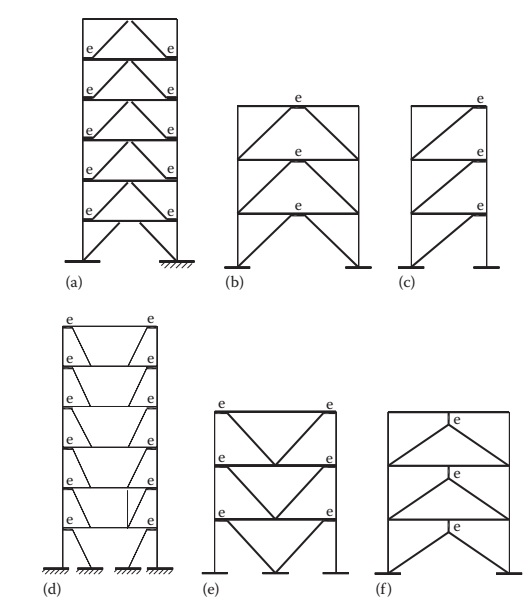Types of eccentric braced frames
Articles > Types of eccentric braced framesCBFs are quite efficient from strength and stiffness considerations and are used widely in lower SDCs A and B.
However, they are of questionable value in seismic regions because of their poor inelastic behavior. Although moment-resistant frames exhibit considerable energy dissipation characteristics, they are relatively flexible when sized from strength considerations alone. Eccentric bracing is a unique structural system that attempts to combine the strength and stiffness of a braced frame with the inelastic energy dissipation characteristics of a moment frame. The system is called eccentric because deliberate eccentricities are designed within the system, typically within the beam segment. The eccentric beam element designed as a fuse limits large forces from entering the braces. The eccentric segment of the beam, called the link, undergoes flexural or shear yielding prior to buckling of compression members. Thus, the system maintains stability even under large inelastic deformations. The required stiffness during wind storms or minor earthquakes is maintained because no plastic hinges are formed under these loads and all behavior is elastic. Although the deformation is larger than in a concentrically braced frame because of bending deformation of the “fuse,” its contribution to deflection is not significant because of the relatively small length of the fuse. Thus, the elastic stiffness of an eccentrically braced frame can be considered the same as the concentrically braced frame for all practical purposes.
Shown in the figure are some common EBF configurations with links at one end of brace.

Eccentrically braced frames can be configured in various forms as long as the brace is connected to at least one link. The underlying principle is to prevent buckling of the brace from large overloads that may occur during major earthquakes. This is achieved by designing the link to yield either in shear or in bending.
The shear yielding of beams is a relatively well-defined phenomenon; the corresponding shear yielding load of a beam of given dimensions can be calculated quite accurately. The resulting axial load and moments in columns and braces connected to the link can also be assessed accurately.
Using certain overload factors, explained shortly, the braces and columns are designed conservatively to assure that in the event of a large earthquake, it is the link that behaves as a fuse without
seriously overloading the columns or braces.
Whether the link develops plastic hinges or yields in shear is a function of its length. Links longer than twice the depth tend to develop plastic hinges while shorter links tend to yield in shear. Accordingly, the links can be identified either as short or long. Short link experiences moderate rotation, while the longer, a relatively larger rotation. The cyclic shear yielding is an excellent energy dissipation mechanism because large cyclic deflections can take place without failure or deterioration in the hysteretic behavior. This is because yielding occurs over a large segment of the beam web and is followed by a cyclic diagonal field. The web buckles after yielding in shear, but the tension field action takes over the load-carrying mechanism to prevent failure, resulting in a robust hysteric loop representative of good energy dissipation characteristics.
 Read also:
Read also:
- Types of concentric structural braces
- historic perspective of special moment frames
- Free Download Portal Method Analyzer
- Retaining walls: Types and failure modes
- Partition walls: types, materials and cost of partition walls
 Share:
Share:
Follow our official Facebook page (@civilengineeringbible) and Twitter page (@CivilEngBible) and do not miss the best civil engineering tools and articles!

